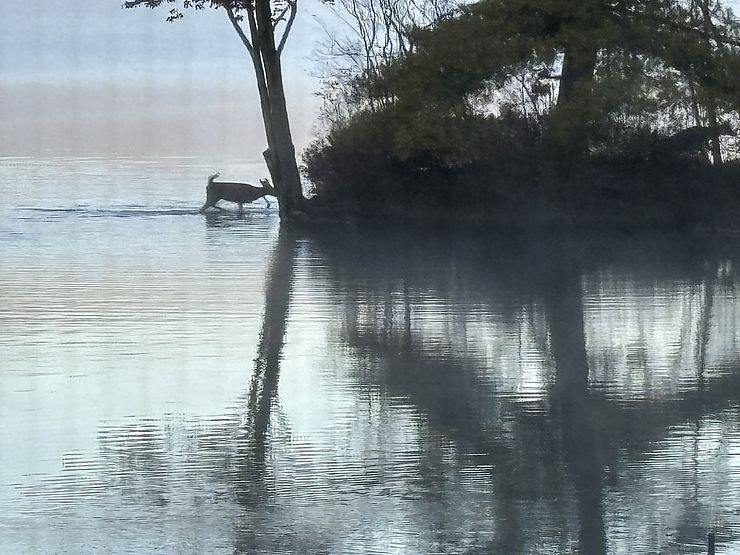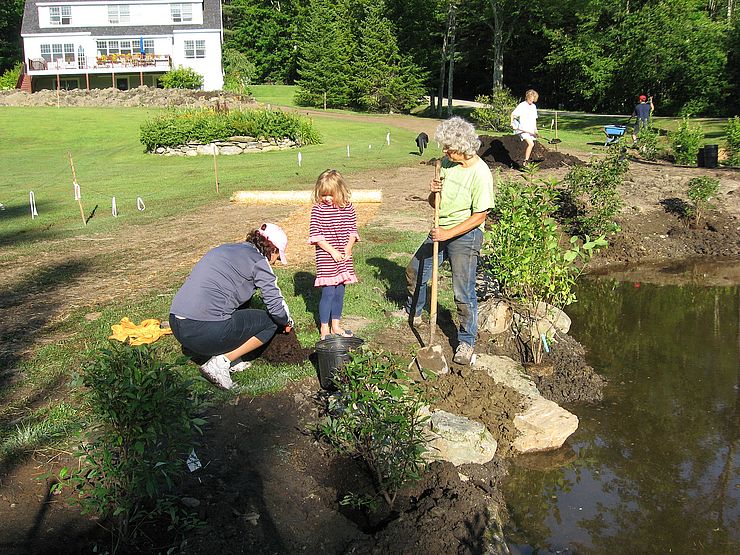
Shoreland Health
Maintaining healthy shorelands is one of the best ways to ensure a healthy lake. Just about everything people do on the land can affect the water quality of our lakes, steams, and rivers. Runoff from lawns, and impervious surfaces, such as driveways, roofs, and roads can carry nutrients and sediment into the lake. Faulty septic systems, excessive use of fertilizer, mowing lawns all the way to the water line, removing native vegetation and trees can all contribute to more runoff coming into the lake. Higher nutrient levels, especially of phosphorus, can feed cyanobacteria (blue-green algae) creating the potential for toxic blooms. High nutrient levels can also encourage excessive aquatic plant growth, especially of invasives such as Eurasian Watermilfo. Using Best Management Practices (BMPs) around the lake, such as creating riparian buffers planted with native species, reducing impervious surfaces, planting rain gardens, and properly maintaining spetic systems can all contribute to a healthier lake. LIA has many programs and projects aimed at enhancing the water quality of Lake Iroquois, preventing further invasives from entering the lake, reducing and controlling the existing invasive Eurasian Watermilfoil (EWM), preventing sediment from entering the lake, and reducing nutrient levels in the lake which feed the invasive EWM.
The Vermont Shoreland Protection (10 V.S.A. 49A) establishes regulations for guiding shoreland development. It applies to acitivities with 250 feet of the mean water level of all Vermont lakes greater than 10 acres. The passage of this act emphasized the importance of protecting lake shorelands in order to ensure the health of our state’s waters.
Lake-friendly land management protects a lake from:
- Nutrient enrichment: In particular, accumulation of the nutrient phosphorus in lakes can invasive plants, such Eurasian Watermilfoil, and cause cyanobacteria (blue-green algae) blooms.
- Sedimentation: Soil eroding from shorelines where native vegetation has been removed is carried with runoff from roads and surrounding properties and deposits nutrients, especially phosphorus into the lake. Sediment from erosion also fills in coves and shallow areas, disrupting fish and amphibian habitat.

Lake-friendly land management focuses on:
- Reducing nutrient runoff into lakes through preventing soil erosion, not using fertilizer on lawns or gardens, and proper installation and maintenance of septic systems.
- Preventing soil erosion through maintenance or reestablishment of naturally vegetated lakeshores, lake friendly landscaping, and use of erosion control measures during construction.
- Preventing runoff that can carry sediment and nutrients into the lake from roads, driveways, and lawns by reducing mown lawn areas (mown grass does not soak up runoff), using rain barrels, and replacing impervious surfaces with pervious surfaces wherever possible.
- Maintenance of vegetated buffers using native plants along lakeshores, creating no mow zones near lakeshores, and conserving undeveloped shores wherever possible.
- Insuring that Best Management Practices are followed along the shoreline.
- Joining the Vermont LakeWise program and creating “lake friendly” shorelines.
- Following the provisions of the Vermont Shoreland Protection Act.
Resources for Lake Friendly Land Management and Healthy Shorelines
- The Lake Iroqouois Association Property Owner’s Manual 5th edition, upated July 2022 (PDF)
- Sharing the Edge: A Guide for Lakeshore Property Owners in Vermont
- The Vermont Lakewise Program
- Best Management Practices for Lakeshores
- Landscape Design for Healthy New England Lakes (PDF)
- Vermont Native Plants List (PDF)
- Septic System Primer (PDF)
- Ensuring Septic System Quality (PDF)
